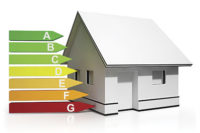The energy saving contributions of thermal mass are well known but not always implemented in an ideal way. There are many examples of buildings designed and built to optimize and take advantage of all the energy savings and comfort that thermal mass has to offer. Some function well, while others are complete failures. There are plenty of examples of passive solar homes built in the 1970s that never came close to living up to predicted performance.
To work correctly in a building, thermal mass must take into account temperature changes on the exterior, as well as temperature changes in the interior. Mass absorbs heat when heat is present and releases the absorbed heat when the temperature drops. In a warm climate, a building with exposed concrete enclosure elements does a good job absorbing the heat of the sun during the day, helping to keep the building cool. When the temperature drops at night, this heat will continue radiating into the space, causing discomfort to the occupants.
In cold climate, this same building will absorb the heat created on the interior of the building and continue absorbing this heat as the temperature drops at night, creating a very energy inefficient situation. Positioned where it works best, thermal insulation has been used on one side of the thermal mass in order to fix this problem. Exposing the thermal insulation to one side of the mass is not always ideal from a durability or energy savings standpoint, and compromises must be made.
Following the Solar Movement
The oil crises of the 1970s spurred many changes in the United States; fuel economy standards for automobiles were developed, renewable energy incentives were introduced, the Department of Energy was formed, and energy conservation for buildings was federally incentivized. Innovative energy saving ideas and strategies also blossomed during this time, the passive solar building movement being one that enjoyed a large following. It was during this time that a concrete sandwich panel called Solarcrete was invented. A thick polystyrene core clad on both sides with 3-inches of concrete, Solarcrete was designed as a solar collector on the south side of buildings in cold climates. The panels were clad with perforated metal panels, painted black; the thermal mass absorbed the heat that was then pulled into the HVAC system serving the building. Because the panels were so energy efficient, Solarcrete soon began providing panels for all of the exterior walls for complete buildings, as the company continues to do today.
The Alpha Solution
Solarcrete panels are the ultimate in energy efficiency for buildings when utilized to take full advantage of their unique characteristics. The panels provide an air-tight enclosure from the footings to the roof, exposed thermal mass to the interior and the exterior, are a composite structural member handling all live and dead loads imposed, and have no thermal bridging due to a reinforced plastic composite connector between concrete wythes.
In the 1980s, to understand how efficient Solarcrete panels are, owner Don Oberlin fitted a 550,000 square feet Solarcrete warehouse, built just outside of Chicago, with several sensors to monitor temperature fluctuations throughout the year. Oberlin was shocked to learn that the space maintained a temperature from a low of 64 degrees Fahrenheit in the winter to a high of 82 degrees Fahrenheit in the summer—without a HVAC system. The high temperature was recorded in the summer during a day that Chicago experienced a 103 degree Fahrenheit day. Perplexed by the outstanding results, Oberlin studied the data more closely and realized that the HID lighting installed in the warehouse was the only heat source the building needed to maintain a comfortable interior in the winter.
Out With the New, In With the Old
Solarcrete is a completely engineered system; panels are factory assembled and shipped to the project site ready for erection and shotcrete application of the concrete wythes. Oberlin has done building panels for as little as $20 per square foot for simple panels with few openings to as much as $35 for square foot for more complex designs in remote locations. The system has been used successfully for custom single family residences, schools, libraries, urgent care clinics, industrial, and retail and commercial buildings. There is no building that this system cannot be used for. It can also be used for existing buildings, modified for a single wythe of cement plaster applied over the polystyrene core attached to an existing CMU or concrete wall.
An old technology that was way ahead of its time when first developed, Solarcrete is enjoying somewhat of a revival on the wave of the current energy efficient, sustainable building movement. Sometimes old dogs don’t need to learn new tricks.









Report Abusive Comment